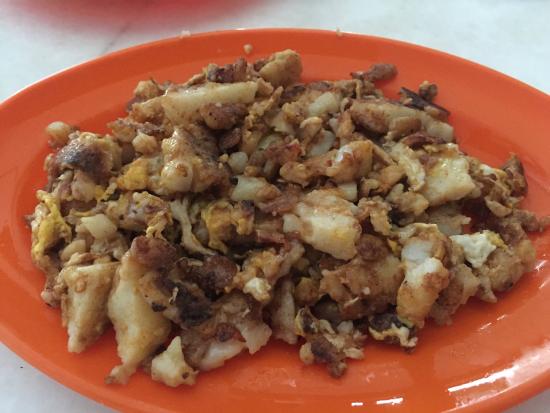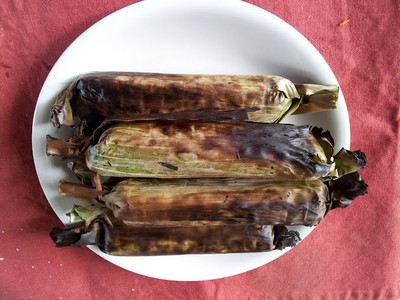In the previous article, RAKAN Sarawak focused on some of the well-known rice-based dishes among the Bidayuh and Iban community.
For this week, we will be looking into some of the rice-based dishes by the Melanau, Malay and Chinese community.
As some of these dishes is also popular among other communities, they may also be known in other names.
How many of these rice dishes have you tried before?
Bacang
Bacang is a traditional Chinese glutinous rice dish. Bacang is made by mixing the rice with various kinds of fillings such as meat, peanut, mushroom and wrapped in dried lotus leaves. It is cooked by steaming the wrapped rice.
Bee pang
Bee pang literally translated as fragrant rice in Hokkien and is a traditional Chinese rice snack typically found in Kuching. The ingredients for bee pang include rice, sugar, peanut, cooking oil, shallot, wheat molasses, salt and sesame seed. Bee pang has a sweet and savoury taste as well as aromatic fragrant from the shallot and a crunchy and soft texture from the peanut and rice. Bee pang is usually sold in the form of small square blocks or sometime in a single entire form.
Cha kueh
Cha kueh is a rice-based dish by the Chinese community and is a popular choice of dish to be eaten while with large group of people. Cha kueh is typically made out of rice flour, water, salt, radish and eggs. To prepare, the cha kueh or rice cake is stir-fried with radishes which has been cut into small pieces and egg until it is golden brown with slightly char to give it a nice crunchy texture.

Typically, in Sarawak cha kueh is available in two version; sweet and salty. For the sweet version, sweet soy sauce is added while the fish sauce is added for the salty version. Cha kueh can typically be found in almost all Chinese food shop or stalls for breakfast, lunch and also as midnight snack.
Pulut panggang
A visit to Sibu is not complete without trying the local’s favourite Malay dish, which is pulut panggang. Pulut means sticky rice, while panggang means grilled refers to the way the rice is cooked, which is over fire and charcoal. To prepare pulut panggang, the rice is mixed with coconut milk, wrapped in coconut leaf and cooked in open fire.

One can choose to have the plain pulut panggang which is the one with no filling and the ones with filling. The latter has pounded dried prawn filling or flavoured grated coconut filling.
In fact, local Sibu people take pride in their pulut panggang so much that a family from Sibu actually made history on the Malaysian Book of Record by making the biggest and longest pulut panggang in 2014.
The title of record went to the family of Sarakawi Bayau. They used 150 kilograms of glutinous rice, santan (coconut milk), five sack of charcoal and heaps of banana leaves and spend 18 hours preparing it before cooking it on an open fire.
As a local favourite, one can generally find pulut panggang everywhere such as the market, coffee shop, and stalls.
Bubur pedas
Bubur pedas is traditional Malay porridge dish that is typically served during Ramadhan. To make bubur pedas, numerous ingredients are used, but it is actually a simple dish to prepare.

It is made from finely ground sautéed rice and grated coconut. Generally, one can use a variety of ingredients for bubur pedas such as any kind of meats and vegetables but the key ingredient for bubur pedas is ‘bumbu’, which gives bubur pedas its spicy flavour. Bumbu is a spice mixture which includes ingredients such as shallot, garlic, red chilli pepper, lemongrass, black pepper and galangal.
In Sarawak, it is not uncommon to see bubur pedas being distributed around to the community during fasting month.
Bubur pedas is also consumed by the Malay community from Sambas, Indonesia.
Nasi aruk
Nasi aruk is a traditional Sarawak Malay rice dish. It is often compared to nasi goreng or fried rice. However, unlike the typical fried rice dish, no oil is used to cook this dish. To prepare this dish, only a few ingredients are used such as shallots, anchovies and of course, rice. This rice dish needs a longer time to cook for a burnt and smoky taste. And as the name might have suggested it, ‘aruk’ means charred in the Sarawak language. The longer the rice is cook in the pan, the dish will achieve the slightly charred and burnt effect.
Nasi goreng dabai
Nasi dabai or dabai fried rice is well-known fried rice dish in Sarawak. While it is can be argued whether it is a Malay dish or not, one can always find nasi dabai being served in Malay coffee shop or stalls. Like any rice dish in this country, nasi dabai can be served for breakfast, lunch and even dinner.

Dabai is a seasonal fruit, and is commonly refer to as the Borneo olive. As dabai is only available during certain time of the year, shop vendors typically used dried dabai or dabai paste for this dish. To prepare nasi dabai, among the ingredients used are shallots, garlic, dried anchovies, dried shrimp, cooking oil, rice and dabai (either actual fruit shredded with the flesh into smaller pieces or dabai paste).
Nasi goreng ikan terubok masin
The nasi goreng ikan terubok masin or salted terubok fried rice is a popular rice dish that can be found in Sarawak. As ikan terubok masin or salted toli shad (Chinese herring) is one of the most prized items in Sarawak, visitors from outside Sarawak would buy them as gift, typically in bulks.
Like nasi dabai, one can usually find nasi goreng ikan terubok masin being served in Malay coffee shops or stalls. In Sarawak, local will usually use ikan terubok masin as the main ingredient for nasi goreng ikan terubok masin. To prepare this simple yet hearty dish, among the ingredients needed are chillies, garlic, shallots, belacan (shrimp paste) and ikan terubok masin that has been deep fried.
Sekupau
Sekupau is made from four ingredients; grated coconut, glutinous rice flour, water and salt.
In Sarawakian Malay, it is also said that sekupau is known as ketupo.

Segurut
Segurut or also known as celoret is a traditional Melanau rice-based delicacy. It is made from glutinous rice flour, coconut milk, grated coconut, palm sugar water and limestone paste. To make segurut, the mixture is first prepared and then poured into the shell made from young leaves of nipah tree, which is typically rectangular in shape. After filling the nipah leaf shell, it is then steamed until cooked.
To eat segurut, the nipah leaf is unwrapped to reveal brownish sticky fragrant of the glutinous rice flour mixture.







[…] How many of these Traditional Rice-based dishes do you know? (part 2) […]